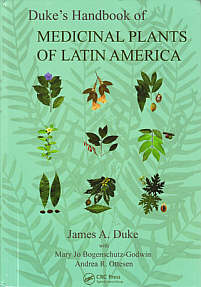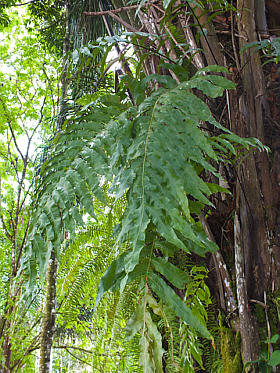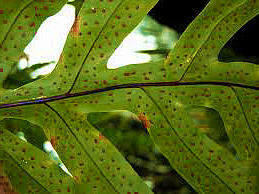, Samambaia is a medicinal fern
that is found throughout rainforests of South America, though it is thought to have
originated from Honduras. Samambaia is just one
member of the Polypodium genus, which has 75-100 species of true fern.
Samambaia, a medium-to-large fern with long-creeping rhizomes,
Uses & Protocols

Hondurans use this herbal to treat
psoriasis, rheumatoid arthritis, general joint pain, and malignant tumors; in Peru, to treat coughs
and problems of the pancreas. In many parts of the Amazon, it revered as a blood
purifier, and general tonic -- much like
Ajo Te.
Health practitioners in the U.S. have also expanded its medicinal uses to
include Alzheimer's, colds, flu, and disorders of the skin, respiratory,
and immune systems, as well as cancer-related cachexia.
 Dosage:
Dosage: Two capsules, twice a day, or as
otherwise directed by your health care practitioner.
Warnings & Contraindications

May potentiate digitalis or similar
prescription heart drugs. Secondly, absorption is reduced in the presence of antacids.
Shelf-Life

Five years or more.

Medicinal Activities
 Further information for practitioners:
Further information for practitioners:
World-famous botanist Dr. James Duke attributes the following activities
to this plant
(p. 526-528; see hardcopy cover at right),
drawn from the extant literature. (See his graduation for "level of
efficacy" on our
amazon traditionals page;
followed by Duke's bibliographic abbreviations (in capital letters),
which we
identify
on a separate page.)

Duke provides a "
food farmacy potential" score for this
plant of "FNFF=???."
- Alterative (f; MBC)
- Anabolic (1; MPG)
- Analgesic (f; MBC)
- Anthelmintic (f; MBC)
- Antiaggregant (1; X8066104)
- Antiaging (1; RAI)
- Antielastase (1; X9434602)
- Antiinflammatory (f1; MBC; RAI)
- Antileukotriene (1; RAI; X8066104)
- Antioxidant (1; RAI)
- AntiPAF (1; RAI; X8066104)
- Antiradicular (1; RAI)
- Antirejection (1; HAD)
- Antirheumatic (f; MBC)
- Antispasmodic (f; MBC; VAD)
- Antitumor (1; RAI)
- Antitussive (1; MPG; RAI)
- Antiulcer (f; AAB)
- AntiUV (1; RAI)
- Antivenereal (f; MBC)
- Antiviral (1; AUS; MPG)
- Astringent (f; MBC)
- Cerebroprotective (1; RAI)
- Corticosteroidal (1; VAD)
- Demulcent (f; MBC)
- Depurative (f; MBC; RAI)
- Diaphoretic (f; DAW; MBC; RAI)
- Diuretic (f1; MBC; RAI)
- Emmenagogue (f; MBC)
- Expectorant (f1; MBC; RAI)
- Febrifuge (f; DAV; MBC)
- Hemostat (f; JFM; MBC)
- Hypotensive (1; RAI)
- IL-6-Inhibitor (1; X12890427)
- Immunomodulator (f1; MBC; RAI)
- Laxative (f; MBC)
- Lymphocytogenic (1; VAD)
- Neuroprotective (1; PHR13:566)
- Pectoral (f; MBC)
- Purgative (f; MBC)
- Sedative (f; MBC)
- Sunscreen (1; RAI)
- TNF-Inhibitor (1; X12890427)
- Tranquilizer (1; VAD)
Indications
 Further information for practitioners:
Further information for practitioners:
Duke provides the following indications for this plant:
- Abscesses (f; RAI)
- Alzheimer's (12; RAI; PHR13:566)
- Anemia (f; MPG)
- Anorexia (f; MBC)
- Arthrosis (1; MPG; RAI)
- Asthma (f; AUS; JFM; MBC)
- Bleeding (f; MBC)
- Boils (f; RAI)
- Bronchosis (f; MBC; RAI)
- Bruises (f; AUS; MBC)
- Cachexia (f; RAI)
- Calculus (f; MBC)
- Cancer (f; JLH; MBC)
- Cancer, skin (f; MPG)
- Cancer, stomach (f; MPG)
- Cardiopathy (f; AUS; JFM)
- Catarrh (f; JFM)
- Cerebrosis (f12; MPG; RAI)
- Colds (f; RAI)
- Colic (f; AUS)
- Constipation (f; AUS)
- Coughs (f; AUS; MPB; SAR; UPH)
- Crohn's (1; MPG)
- Dementia (f12; RAI)
- Dermatosis (f12; MBC; RAI)
- Diabetes (1; MBC; MPG)
- Diarrhea (f; MBC)
- Dropsy (f; MBC)
- Dysmenorrhea (f; MPG)
- Dyspepsia (f; AAB)
- Eczema (1; MBC; MPG)
- Fever (f; DAV; EB25:239; MBC)
- Flu (f; RAI)
- Fractures (f; MBC)
- Gastrosis (f; AAB; MBC)
- Gout (f; MBC; RAI)
- Hepatosis (1; MPG)
- High Blood Pressure (f; AAB; AUS; MPG)
- Hoarsness (f; JFM)
- Infection (1; MPG)
- Lactose-Intolerance (1; VAD)
- Leukorrhea (f; MPG)
- MS (1; MPG)
- Nephrosis (f; AUS; DAV; MBC)
- Neurosis (1; PHR13:566)
- Oliguria (f; AUS)
- Ostealgia (f; MBC)
- Osteoarthritis (1; VAD)
- Pain (f; AAB; MBC; MPG; RAI)
- Pancreatosis (f; DAV)
- Pertussis (f; DAV; EBS; MBC)
- Psoriasis (f12; MBC; MPG; RAI)
- Pulmonosis (f; MPG)
- Respirosis (f; JFM; RAI)
- Rheumatism (f1; MBC; MPG; RAI)
- Snake Bite (f; MBC)
- Sores (f; AAB; JTR; MBC)
- Sprains (f; JTR)
- Stomacheche (f; JTR; MBC; MPG)
- Stomatosis (1; MPG)
- Stones (f; MBC)
- Sunburn (f; RAI)
- Syphilis (f; MBC)
- Tendonosis (f; RAI)
- Tumors (1; RAI)
- Ulcers (f; AAB)
- UTIs (f; RAI)
- Vaginosis (f; MPG)
- VD (f; DAW; MBC)
- Viruses (1; AUS; MPG)
- Vitiligo (f12; MBC; PHR13:566; RAI)
- Worms (f; AUS)
- Wounds (f; AUS)





